January 29, 2016
Air Date: January 29, 2016
FULL SHOW
SEGMENTS
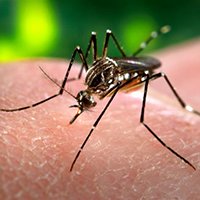
Zika’s Emergence in a Changing Climate
View the page for this story
An emerging Zika epidemic and its association with a worrisome birth defect has pushed a formerly obscure infection into the spotlight. Along with other vector-borne diseases such as dengue and West Nile, climate change is probably accelerating the spread of Zika, as mosquitoes also spread to new areas. Dr. Kamran Khan, an infectious disease physician, tells host Steve Curwood about growing global public health concerns and how the virus might be controlled. (07:50)

The Campaign and Climate Change
View the page for this story
Host Steve Curwood tracks down more presidential candidates to report on their climate change stances prior to the New Hampshire primary. Seeking the Republican nomination, Texas Senator Ted Cruz expresses skepticism about the science and argues that acting on climate change kills jobs. Meanwhile, chasing the Democratic nomination, former Secretary of State Hillary Clinton believes renewable energy could be a boon to the American economy, and Vermont Senator Bernie Sanders invokes the moral outrage of future generations to drive home the urgent need to act. (06:40)
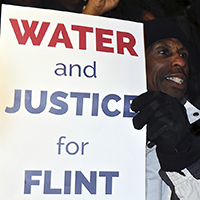
Flint and Environmental Racism
View the page for this story
Prof. Robert Bullard, the “father of environmental justice”, says that the lead water disaster in Flint, Michigan is just the latest example in a long history of environmental injustice in the United States. Prof. Bullard, Dean of the School of Public Affairs at Texas Southern University, tells host Steve Curwood that the working class and communities of color like those of Flint are far more likely to be exposed to toxic substances like lead. (11:50)
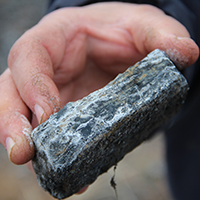
Defunding the Clean up of Abandoned Coal Mines
/ Reid FrazierView the page for this story
Abandoned coal mines must be cleaned up for the health of the environment and regional waterways. But much of the funding for these projects comes from fees on new mines. Now with the slump in coal use, there’s less money to straighten up the toxic legacy of coal mining's past. The Allegheny Front's Reid Frazier reports. (06:30)
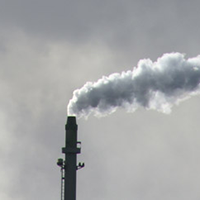
The Paris Climate Accord Could Activate A Powerful Part of the Clean Air Act
View the page for this story
The US Congress is unlikely to pass new carbon pricing legislation any time soon. But Columbia Law Professor Michael Burger tells host Steve Curwood there’s a little used provision in the Clean Air Act, Section 115, that gives the EPA the authority to go beyond the Clean Power Plan and institute broad market-based mechanisms such as cap and trade to combat climate change in conjunction with other nations.The Paris Agreement could make Section 115 a game-changer. (08:20)

Beyond the Headlines
/ Peter DykstraView the page for this story
In this week’s trip beyond the headlines, Peter Dykstra tells host Steve Curwood that President Obama’s ambitious goal for electric vehicles has fallen short but a non-profit that tracks environmental crimes and accidents from the skies is a great success. Also, we mark the anniversary of the Ramsar Convention, an international agreement to protect wetlands. (03:40)

BirdNote: Costa Rica's Morning Chorus
/ Mary McCannView the page for this story
In Costa Rica, the vibrant colors of a winter sunrise are closely rivaled by the exuberance of its birdsong. BirdNote’s Mary McCann reports that while some of Costa Rica’s bird species hide from sight, their calls are highly distinguishable. (01:50)
Show Credits and Funders
Show Transcript
HOST: Steve Curwood
GUESTS: Kamran Khan, Robert Bullard, Michael Burger
REPORTERS: Reid Frazier, Peter Dykstra, Mary McCann
[THEME]
CURWOOD: From Public Radio International, this is Living on Earth.
[THEME]
CURWOOD: I'm Steve Curwood. As the climate warms, insects like mosquitoes can expand their range, bringing new, exotic and unwelcome threats, like the Zika virus.
KHAN: You know, we know that temperature for instance is a very key driver for the ability of the mosquito to replicate, for the ability of the mosquito to survive long enough to transmit the virus that it happens to be carrying. So I think climate change is probably an important factor here.
CURWOOD: There’s no easy way to fight this disease and potentially disastrous birth defects. Also, as the US turns to cleaner fuels, coal use slumps, and that means far less cash to clean up old mine waste.
CAVAZZA: We were a leader in mining for a very long time, fueled a couple world wars and the industrial revolution. So, unfortunately we're left with many problems from that.
CURWOOD: That and more this week, on Living on Earth. Stick around.
[NEWSBREAK MUSIC: Boards Of Canada “Zoetrope” from “In A Beautiful Place Out In The Country” (Warp Records 2000)]
ANNOUNCER: Support for Living on Earth comes from United Technologies – innovating to make the world a better, more sustainable, place to live.
[THEME]
Zika’s Emergence in a Changing Climate
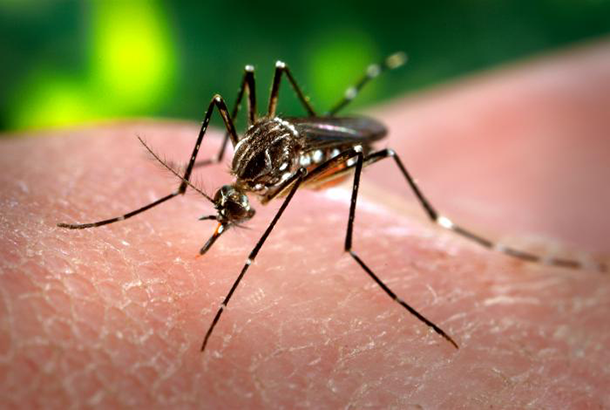
Aedes aegypti feeding on a human. (Photo: CDC, public domain)
CURWOOD: From the Jennifer and Ted Stanley studios at the University of Massachusetts Boston and PRI, this is Living on Earth. I’m Steve Curwood. The changing climate and growth of international travel is making it easier for infectious diseases carried by insects to find new victims. We’ve seen dengue fever, the West Nile virus and the hanta virus spread and now it seems we need to brace for the mosquito-borne Zika virus, which is linked to a devastating birth defect. At least 18 cases have been reported in the United States, mostly among travelers, although there are locally transmitted cases in Puerto Rico. The Centers for Disease Control advised pregnant women to avoid the 24 countries where Zika is widespread. For more information and advice we reached out to Dr. Kamran Khan at the University of Toronto, who recently published a paper on Zika in the Lancet. Welcome to Living on Earth, Dr. Khan.
KHAN: Thank you, it's great to be here.
CURWOOD: Doctor Khan, Zika has been around humans are more than 50 years, so why is it suddenly capturing our attention?
KHAN: Well, you're right. Zika virus was first identified in Uganda in 1947. It's actually named after the Zika forest there, and it's been causing sporadic cases over the last 50 years or so. In 2007, it found its way into the island of Yap in Micronesia, caused a bit of an epidemic there, and it's been island hopping to French Polynesia to Easter Island and now more recently into Brazil. We're hearing about it because it's found a really hospitable environment in Brazil. 200 million people with essentially no immunity to this virus, the mosquito that is efficient at transmitting it, the Aedes aegypti mosquito, and the suitable climate, so it's all the makings of an epidemic.
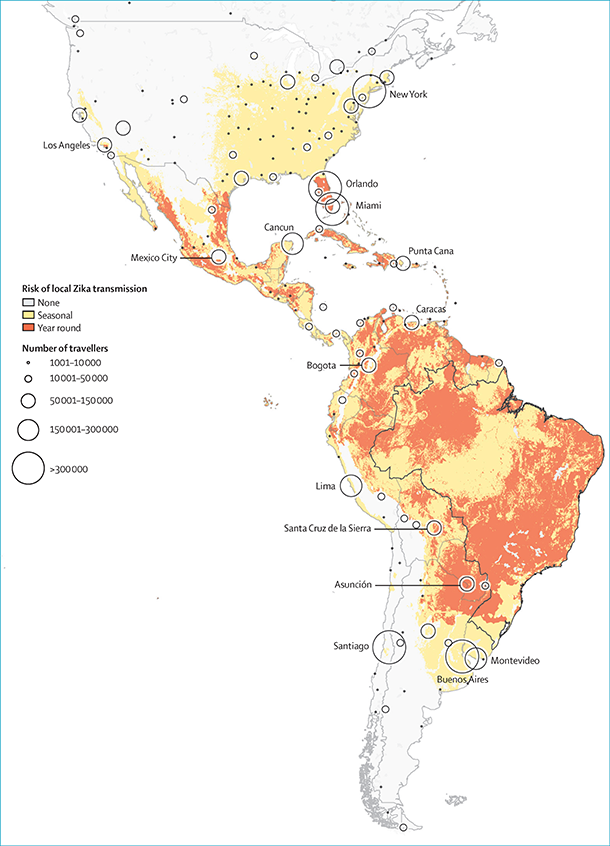
Map of Zika’s anticipated spread, generated by Dr. Khan and his paper coauthors. Yellow indicates regions at risk of seasonal Zika transmission, while orange denotes areas at risk of year-round Zika transmission. (Photo: courtesy of Dr. Kamran Khan)
CURWOOD: Now, how long and why have you studied the Zika virus?
KHAN: I first became aware of Zika in May of 2015 when it first showed up in Brazil and started to work with several of our colleagues at Oxford that actually spent a lot of time studying the Aedes mosquito and its ability to transmit viruses, and our work here in Toronto on understanding how people work and travel around the world. We essentially put our skills sets together trying to anticipate and model how this disease would spread across the region.
CURWOOD: Tell me specifically about what you published in the Lancet? How might the Zika virus spread outside of South America?
KHAN: We first took a look at how people are traveling out of Brazil, and this is important because if an individual is bitten by a mosquito that carries the Zika virus, they can board a plane and go to another part of the world that has the Aedes mosquito that can transmit the virus and infect that mosquito if the mosquito bites them. That mosquito can then propagate the infection and take it on others. So what we did was we looked at the movements of travelers out of Brazil because we knew that this virus was widespread in the region, and we coupled that with information on where Aedes mosquitos are across the Americas and where the climate is suitable for it to be transmitted to humans. The US has a large footprint in terms of travelers around the globe, so we're very likely to see and are already seeing travelers who are already infected with the virus returning to the United States. That's very different than individuals who haven't left the United States who become infected by mosquitoes in the US. Now, our research suggested that some areas of Florida, the Gulf coast, parts of southern Texas, the environment there is suitable and the mosquito is present for possible local transmission of Zika virus. I don't anticipate in the US they would be the types of explosive epidemics we're seeing in other parts of Latin America. Climate isn't the only factor, but the conditions are there and conducive to that.
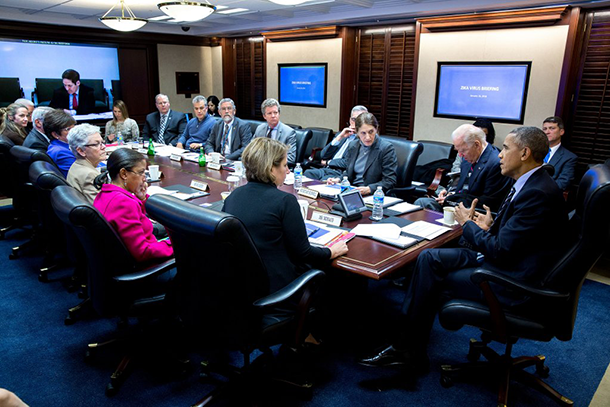
President Obama met with his national security and health teams on the spread of the Zika virus on Tuesday, Jan. 26th. (Photo: Official White House Photo by Pete Souza)
CURWOOD: Now, the public is really engaged with this because of...well, it sounds like a horror story that you get this disease, a woman who gets this disease during pregnancy, her baby could be born with a smaller brain, microcephaly. So what's the relationship between Zika and this rise in microcephaly?
KHAN: We know with other viruses, Rubella is one that was known to also cause microcephaly and congenital defects in newborns.
CURWOOD: Rubella is something that people often called German measles right?
KHAN: Correct. So Rubella is a condition which individuals can pass this virus onto their unborn child, which can cause microcephaly and other types of birth effects. At this point time there is growing evidence that the Zika virus is associated with microcephaly. The first bit of evidence really came from this epidemiological link, meaning that we were seeing a dramatic rise in microcephaly cases in parts of Brazil, especially in the northeast where the Zika virus was most active going from about 150 cases a year to well over 3,500 cases. I think the most compelling evidence has been that the Zika virus has been identified in the brains of newborns who died shortly after birth and had microcephaly, as well as in the placentas of some women who miscarried and had stillborns with microcephaly. We still don't know for certain whether Zika is the primary cause or a contributing factor and this is why there is an ongoing investigation to better delineate what the risk is.
CURWOOD: What do you think of the advice to people in these regions to not get pregnant at this point until this is figured out?
KHAN: I think it's a sign just of the desperation in the situation. I mean, when in history have we heard of a policy of "don't get pregnant", but I think it's also important to keep in mind that there's no vaccine on the immediate horizon and there's no effective anti-viral treatment, and this is a day biting mosquito predominantly. So you can just imagine individuals living in a very warm tropical climate and really their only measure to prevent mosquito bites would be to cover up, to be applying mosquito repellant very frequently and we know that that's not even 100 percent effective.
CURWOOD: What might work to combat the spread of this disease or the mosquitoes that carry it?
KHAN: Controlling mosquito populations, eliminating some of the breeding sites, but there have been some more novel interventions proposed. Some organizations are trying to engineer mosquitos that could be released into the wild and if they mate they could result in offspring that are not viable. Essentially the mosquito populations would start to diminish. There is another approach that's been used with Dengue which is a related virus where the mosquito is infected with a bacterium called Wolbachia and in that instance the bacterium seems to actually disrupt the ability for the mosquito to transmit the Dengue virus to humans. These are in consideration. It is important to keep in mind they not going to address the problem in a span of weeks or months for instance.

Dr. Kamran Khan is an infectious disease physician at St. Michael’s Hospital in Toronto and a professor at the University of Toronto. (Photo: courtesy of Dr. Kamran Khan)
CURWOOD: To what extent is this outbreak related to our disrupting climate, that things are getting warmer, and places where mosquitoes can flourish, are expanding or moving?
KHAN: Well, if we look at the Aedes mosquitoes, over last 50 years or so we've seen a very dramatic expansion of their geographic range around the world. Now on the one hand that expansion is probably related just to globalization, meaning travel and trade and the movements of these mosquitoes to different parts of the world. But I think climate change is probably an important factor here as well. We know that temperature, for instance, is a very key driver for the ability of the mosquito to replicate, or the ability of the mosquito to survive long enough to transmit the virus that it happens to be carrying, so I think climate change is probably an important factor here.
CURWOOD: Dr. Kamran Khan is an infectious disease physician at St. Michael's Hospital in Toronto and teaches at the University of Toronto Medical School and School for Public Health. Thanks for taking the time today, doctor.
KHAN: My pleasure.
Related links:
- “Anticipating the international spread of Zika virus from Brazil” by Kamran Khan et al
- Obama briefed on Zika virus, urges faster work to develop tests and vaccines
- Rights groups denounce Zika advice to avoid pregnancy in Latin America
- The Zika virus foreshadows our dystopian climate future
- El Salvador’s Advice on Zika Virus: Don’t Have Babies
- Zika virus: Outbreak 'likely to spread across Americas' says WHO
- How climate change could worsen the spread of Zika virus and other infectious diseases
- More about Zika Virus, symptoms, diagnosis and treatment via CDC
- Genetically Modified Mosquitoes Join The Fight To Stop Zika Virus
- U.S. Launches ‘Full-court Press’ for a Zika Vaccine
- Here’s what it will take to stop the Zika virus outbreak
The Campaign and Climate Change

Secretary Hillary Clinton highlighted the economic opportunities created by addressing climate change at a recent rally in Rochester, New Hampshire. (Photo: Steve Curwood)
[CROWD NOISES]
CURWOOD: I’m back out on the campaign trail in snowy New Hampshire chasing presidential candidates as they discuss – or don’t discuss – the environment. On a cold night in Rochester I stopped by a campaign rally for Texas Republican Senator Ted Cruz. It was an older and mostly conservative crowd with former NH House speaker Bill O’Brien and former US Senator Bob Smith on the platform. But though Senator Cruz talked about his religious beliefs he said nothing about the environment or climate change and no one took the microphone to ask about them. So as the rally broke up, I waded into the crowd to ask myself.
CURWOOD: What does your faith tell you about how we should care for creation?
CRUZ: Well, look, of course we have to be good stewards of the environment, we have to care about clean water and clean air. I think that is very very important. What unfortunately has been the case in this administration is that many people in the EPA are not focused on clean air and clean water, but instead have behaved like zealots, just shutting down human development and I think that's the wrong approach to take. We need a common sense approach. Look, when it comes to clean air and clean water, what happened in Flint, Michigan, for example, is an absolute disaster, and it's a failure of government at every level. That's what we need to be doing is protecting the water supply so that people aren't being poisoned. We shouldn't be using regulations to shut down jobs and economic growth for the country.
CURWOOD: So global warming...
CRUZ: I think it needs to follow the science and the data.
CURWOOD: And the science is wrong?
CRUZ: I chaired a hearing a couple of months ago. I'm the chairman of the science and space subcommittee of the Senate Commerce Committee on the science behind global warming. We brought in expert scientists. The data do not back up the theory that the politicians are pushing, and in particular, the satellite data demonstrate that for the last 18 years there has been no significant warming measures whatsoever. The computer models say it should be warming like crazy. The satellites that are actually in the atmosphere measuring the temperature show that it's not happening, and so I don't think we should follow political theories when they are contradicted by the science.
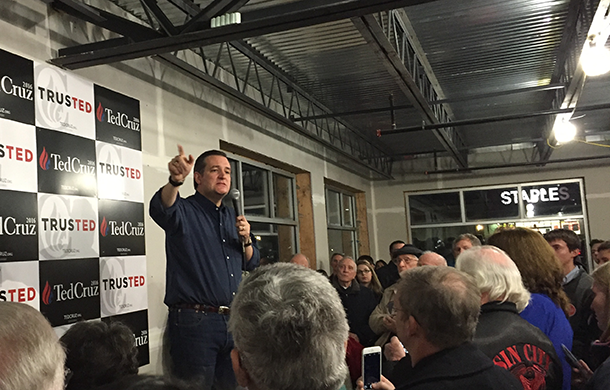
Despite evidence from NASA that confirms the Earth is warming, Texas Senator Ted Cruz continues to assert that satellite data show no temperature increase on Earth over the last eighteen years. (Photo: Steve Curwood)
CURWOOD: By the way, scientists at NASA now say observational errors in the oceans made it first appear there had been little warming over the last 18 years, but now those satellite data biases have been corrected and there is no doubt - the Earth is getting hotter.
A few days later across town at Rochester city hall and opera house, New Hampshire’s Democratic US Senator Jeanne Shaheen introduced Hillary Clinton. There were plenty of women in an older and decidedly more liberal crowd, and they cheered the Secretary’s ideas for rebuilding the economy.
HILLARY: There are so many jobs that not only could we create here with the proper incentives in our tax code, we could actually bring those jobs back from overseas by giving businesses more reason to invest right here in America.
[APPLAUSE]
And one of the biggest opportunities for job creation is combating climate change. Now, that's not only something we have to do for our own sake, and it's something I've been working on for years, because I know it's serious. I love it when the Republicans as they often do are asked about climate change and you know what they say, they say, "Well, I don't know. I'm not a scientist." And my response to that is “go talk to a scientist and actually listen to a scientist”and understand what are we up against. But what they don't seem to get either is this is a great job opportunity. There are so many jobs in clean renewable energy to be built in this country.
[APPLAUSE]
They can't be exported, they have to be done, right here. If you're putting up wind turbines, if you're putting up solar arrays or photo voltaics, if you're working on geothermal, if you're working on biofuels and advanced biofuels which are now being tested as Jeanne knows, for use in our Navy ships and Air Force planes, that’s American ingenuity, our creativity, our technology at work right here.
[CROWD SOUNDS]
CURWOOD: Vermont Senator Bernie Sanders put the climate front and center at Southern New Hampshire University in Manchester, energizing his mostly young Democratic primary supporters. Fellow Vermonter and 350.org co-founder Bill McKibben introduced him, saying it’s vital to take on climate change now.
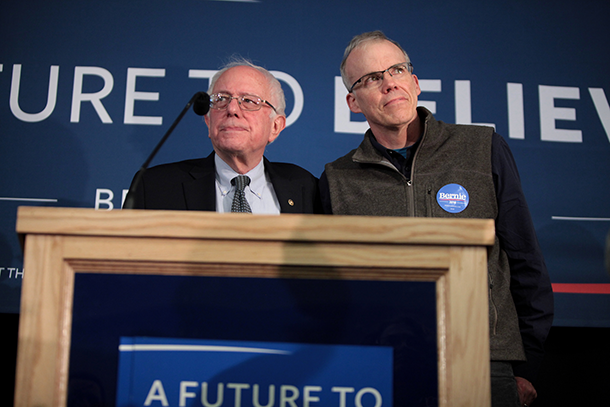
Accompanied by fellow Vermonter Bill McKibben, Senator Bernie Sanders brought home the message of the urgency of acting on climate change for the sake of future generations. (Photo: Gage Skidmore, Flickr CC BY-SA 2.0)
MCKIBBEN: NOAA, the National Ocean and Atmospheric Administration announced that 2015 had indeed been the warmest year on record, and not by a little, by a lot. We're beginning to break apart this planet.
SANDERS: But what Bill understands, and what this campaign understands, he understands that if we're going to deal with the crisis, the enormous crisis of climate change, it's not going to be a handful of environmentalists just publishing important papers. That's important. We need a grassroots movement all over this country and all over the world. And I was so pleased a year and a half ago to be in New York City. When was that, Bill?
MCKIBBEN: Sept. 2014
SANDERS: We had, what, 400,000 people marching and say Congress and the world, we have a huge crisis, and it has to be addressed. And I was particularly pleased to see so many young people, and people of color, from all over our country and all over the world saying that this is an issue that we have to deal with and have to deal with boldly. And I often think, as the father of four, and as the grandfather of seven beautiful, beautiful grandchildren that they will look back on this time. They and the children all over the world. And I want you to think about this, think about 50 years from now when more droughts and more floods and more extreme weather disturbances and more acidification of the oceans and the unbelievable impact that that has on our lives, more sea level, rising sea level, more conflict as people fight for limited natural resources. And 50 years from now, they're going to look back on us and say,“the scientists told you what would happen...why didn’t you do what you had to do?”
CURWOOD: The crowd loves the urgency, but the question now is what will voters do. And it’s unclear how much the upcoming primary and general elections will turn on the issue of climate change and our responsibility to act to avert its dangers.
Related links:
- Hillary Clinton campaign, “Taking on the global threat of climate change”
- Bernie Sanders campaign, “Combating Climate Change to Save the Planet”
- “Fact-check: Ted Cruz’s claims about climate change science”
- Federal programs marked for elimination on Ted Cruz’s website: 10 of 25 involving climate change
- Republican presidential candidates go their own way on climate change despite Paris agreement
- Our previous coverage tracking the candidates: The Changing Climate in the GOP Race
- Twitter fight! Bernie and Hillary battle it out over who has the better climate plan
[MUSIC: James Sanderon/US Army Band Pershing's Own, Hail to the Chief]
CURWOOD: Just ahead, lead poisoned water and environmental racism. Stay tuned to Living on Earth.
[CUTAWAY MUSIC: Jeffrey Taylor, Shall we Gather at the River, Cumberland Records]
Flint and Environmental Racism
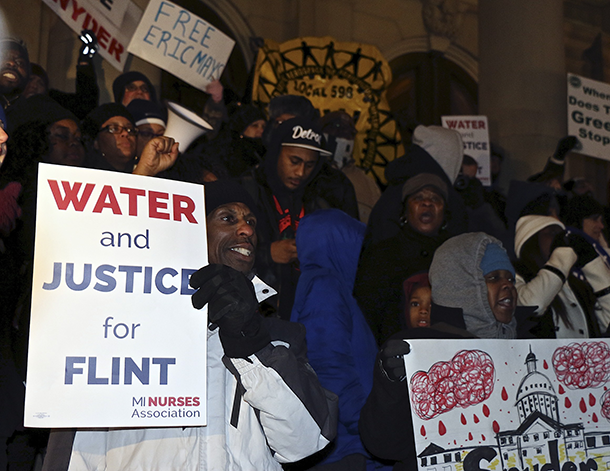
People of color are especially vulnerable to environmental injustice and environmental racism. (Photo: courtesy of Petra Daher)
CURWOOD: It’s Living on Earth, I’m Steve Curwood. Working with local residents, the NAACP – the National Association for the Advancement of Colored People — has developed a 15 point plan of recovery for Flint, Michigan, beleaguered by an epic water crisis related to lead contamination. A top concern is the return of local control of government for this city of more than 100,000, which has a black majority population, and many getting by on low incomes. The lead poisoning of the citizens of Flint and the long delays in addressing it make for a classic case of environmental racism says Professor Robert Bullard, a noted author and expert on environmental justice.
BULLARD: The Flint water case is the latest poster child for environmental justice. You have the coming together of a perfect storm, you have a low-income community or city, over 40 percent that's below poverty, you have a majority black city. You have a city that's already under stress economically whose democratic process has been removed from the local residents, and you have a decision made by other people who don't live in Flint about their water, and water is life.
CURWOOD: What happened to Flint that residents there lost the ability, the legal ability, to govern themselves and what relation to race do you think that might have?
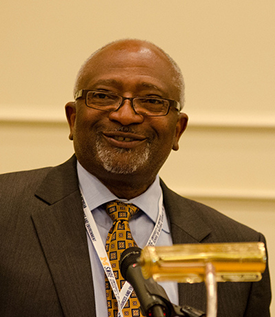
Robert Bullard is the Dean of the Barbara Jordan-Mickey Leland School of Public Affairs at Texas Southern University in Houston, Texas. He is often described as the father of environmental justice. (Photo: Michigan School of Natural Resources & Environment, Flickr CC BY 2.0)
BULLARD: Well, if you look across the state, the cities that are under state control or in receivership, most of them are majority people of color, and I think any time you have the power of duly-elected officials of a municipality stripped, and you have an overseer type government, a disaster manager so to speak, you may get decisions which may be totally different than if people who voted and lived in the city and worked in the city and were concerned about the health of residents. And I think that process of having someone to decide your own fate, that's the heart of the environmental justice movement. You know, for too many cases, from Flint, Detroit, and Cleveland, Houston, LA, you start naming the cities. Oftentimes things are placed in communities of color and low-income companies and residents didn't decide it, they didn't have there political process of voting to determine what goes in and how much comes out, and that's the justice and the equity issue that I think the Flint case is bringing to light.
CURWOOD: Now, apparently it took more than a year and a half or on the scale of a year and a half for attention to be properly paid to the the disaster, the lead poisoning disaster in Flint. Why did it take so long, do you think?
BULLARD: Well again the Flint case fits the example of what's happening on environmental justice across-the-board. Environmental problems of pollution and environmental degradation or response to disasters and health threats, they often take longer to be acknowledged, it takes longer for the response, it takes longer for the recovery in communities of color and low-income communities, so it didn't surprise me that it took so long for this to come to light because many of these environmental justice problems and challenges that impact low-income and communities of color, they're invisible, they're invisible to the state government, invisible to the federal government, to county officials, not that community residents don't know about them and have not been complaining about them, but they are invisible when it comes to the response.
CURWOOD: This is environmental racism. What do you think motivates environmental racism in this and other cases?

Michigan Governor Rick Snyder’s office released this Flint Water timeline to address questions on who knew what and when. According to the FlintWaterStudy, this timeline is missing some information, but overall is reasonably accurate. (Photo: Office of Michigan Governor Rick Snyder)
BULLARD: Well, I think the fact that environmental racism exists because in the real world, there are some communities that are not considered equal and valued the same as others. We have young people today talking about Black Lives Matter and I think that whole concept grows out of the fact that black communities and communities of color have not mattered for so long when it comes to giving equal protection, providing civil rights and human rights and so this whole notion of environmental racism, it's real. It's so real that even having the facts, having the documentation, having the information has never been enough to provide equal protection for people of color and poor people.
CURWOOD: Why is that?
BULLARD: Well because our society is a long way from being race neutral. Racism permeates every institution in our society. It permeates voting, it permeates housing, education, employment, so we should not be surprised that racism also permeates the way that environment decisions are made.
CURWOOD: America has a president of recent African descent, and yet the Environmental Protection Agency, the region five that had Flint in its portfolio, dragged its feet, indeed, obstructed the work of a low-level worker who was trying to deal with the situation fitting into this pattern of environmental racism. We have a black president. Why do we still environmental racism in this country?
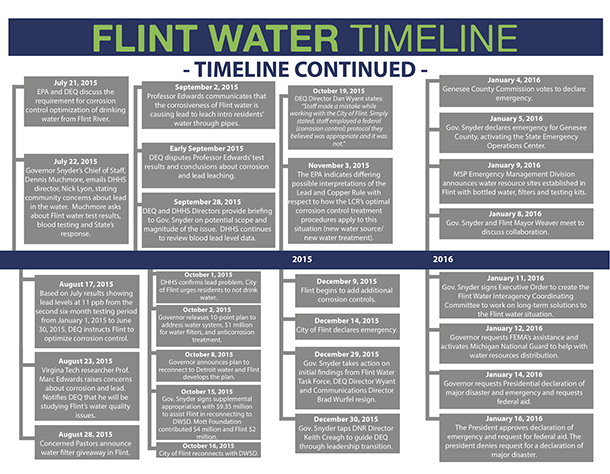
Timeline, continued. (Photo: Office of Michigan Governor Rick Snyder)
BULLARD: Well, you have to understand that the way the EPA operates is that you have the federal EPA headquartered in Washington, DC, and you have 10 regions, and the regions operate almost as autonomous little EPAs. Regional EPAs work very closely with the state departments of environmental quality and too often that relationship, that cozy relationship, gets in the way of protecting the most vulnerable communities, and so EPA regional offices will oftentimes communicate information with the state agencies and leave the impacted community out of the loop. And so even when you get complaints from Flint residents to the state officials that go up to the EPA, if that's not acted upon you have to question whether not those individuals should be in those offices with the power and authority to control what happens in communities.
CURWOOD: Compare the national response to the natural gas leak, the massive natural gas week in Porter Ranch, California, just outside of Los Angeles. Compare that response to what happened in Flint.
BULLARD: Well, I think the fact that we are talking about two different scenarios, we're talking about two examples, and so when you talk about the nature in which state officials and regional EPA officials have responded to the actions that were taken in Flint, Michigan, in a defensive way, whereas in California, I think, they have been responsive and the actions that have been taken, you don't see the kind of push back, you don't see the level of pushback. I think what this shows is that race and class still matter in terms of how the government response will be pushed forward. I'll give you an example of ... I saw this up close and personal with how the waste that was cleaned up, the coal ash was cleaned up after the spill in Eastern Tennessee. All levels of government got behind the state of Tennessee to clean up that waste from the coal plant in eastern Tennessee in Roane county which predominantly white. But when the decision was made where to send this waste and where to dispose of it, the people in Tennessee said, “no we don't want this stuff disposed in our state or in our county”, and decision-makers at the state EPA in region four, the EPA in Atlanta decided OK, the best place to put it is to ship it 300 miles south to Perry County, Alabama, to Uniontown, a predominantly black county and predominantly black city that is very poor in Alabama, send it to the Alabama black belt. So if it's so poisoned for Eastern Tennessee, mostly white, very white, why is it not the same consideration given to a poor black area? That's the kind of blatant decision-making at the federal, state, and local level that really don't consider equity and outcomes that on their face may appear to be race neutral, but the outcome is that you're taking waste from white areas and shipping it to black areas and we say that is environment racism.
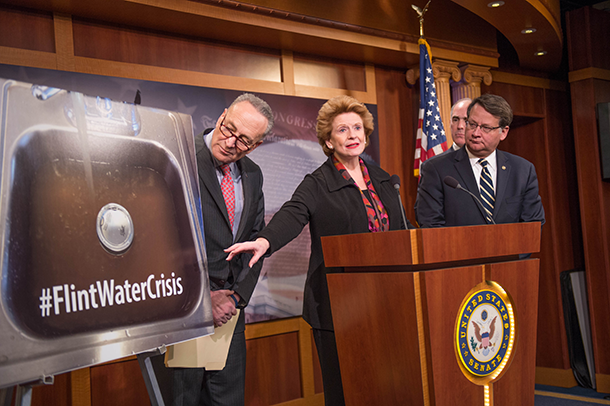
Michigan Senators introduce bill to provide support to families in Flint. (Photo: Senate Democrats, Flickr CC BY 2.0)
CURWOOD: What about the question of climate change? To what extent is that an environmental justice issue?
BULLARD: Climate exchange is probably the number one environmental justice issue of our time. It is the global environmental justice issue, the communities that have contributed least to global warming and climate change will feel the impacts first, worst and longest, and I think the environmental justice movement, and the climate justice moment speak to this issue not just in terms of parts per million and CO2 and greenhouse gases, but also talk about the equity impact of climate change and talk about the solutions in that real solutions bring to the table those communities that have historically been left out of the environmental decision-making. Our communities, our front-line communities have to be in the room, have to be at the table and have to be part of any solution going forward as it relates to climate action plans.
CURWOOD: Now, you brought some students from historically black colleges and universities to Paris for the climate summit. What was that process like?
BULLARD: Well, because the climate change movement historically has not represented all of the diversity of our country, a group of us decided, Dr. Beverly Wright at Dillard University and myself, we decided to come together and form the Historically Black College and University Consortium on Climate Change, and we decided that we will raise the money and bring our young emerging leaders and at our HBCUs to Paris for the COP 21. We were able to bring 50 students from 15 universities from Texas all the way across the Gulf Coast and South Atlantic and as far north as Pennsylvania. We bought the students and some faculty mentors who were working on climate and working on all kinds of STEM research and policy. We said that these young people, African-American students, needed to see how policies are being made and what was decided in December in Paris in 2015 will impact these young people going forward. And so they need to be in Paris to show that African-Americans are concerned about climate change and we are in solidarity with other people around the world and showing that the issues that impact people of color and people in the developing world, we have those same issues in our own country as is relates to climate justice.
CURWOOD: Bob, I think it was back in 1990 you wrote the book Dumping in Dixie: Race, Class and Environmental Quality. What's changed since then and what gives you hope for more change?
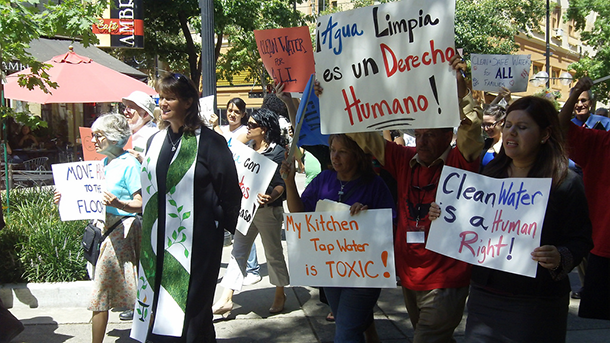
Clean water activists (Photo: Unitarian Universalist Service of California, Flickr CC BY-NC-ND 2.0)
BULLARD: Well, when I wrote Dumping in Dixie in 1990, Dumping in Dixie was the only book, it was the environmental justice Bible at the time. Today if you Google or if you look on the Internet and search for environmental justice books there's hundreds of books on the topic. There's lots of researchers doing environmental justice scholarship. I see more and more courses and programs at college and universities integrating these concepts of justice into the curriculum across-the-board, and if you look at this whole notion of Dumping in Dixie and environmental justice we confine that book to the southern United States, but today is environmental justice covers not just the United States but environmental justice now is a global movement and the issues and the framing has spread across the globe. To me, that's the maturation of our movement.
CURWOOD: Robert Bullard is the Dean of the Barbara Jordan - Mickey Leland School of Public Affairs at Texas Southern University. Thanks for much for taking the time today, Bob.
BULLARD: My pleasure.
Related links:
- About Robert Bullard and his work
- Read about Environmental Injustice in Flint
- It’s not just Flint: Poor communities across the country live with ‘extreme’ polluters
- What Zika and the Flint Water Crisis Have in Common
- Bullard: Flint is part of a pattern: 7 toxic assaults on communities of color
- How the EPA Has Failed to Challenge Environmental Racism in Flint—and Beyond
- A Question of Environmental Racism in Flint
- More on Environmental Justice Movement and the history of Environmental Racism
- Gas Leak in Los Angeles Has Residents Looking Warily Toward Flint
Defunding the Clean up of Abandoned Coal Mines
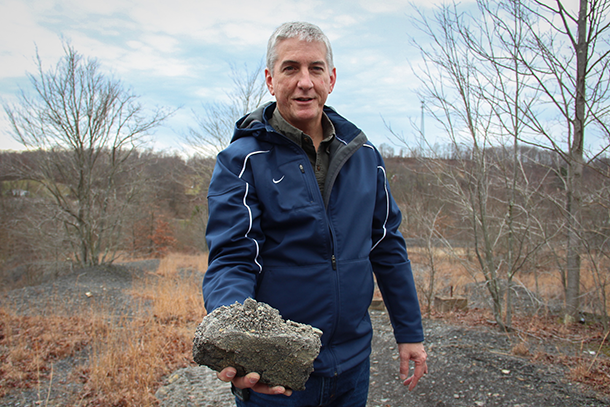
Eric Cavazza, director of Pennsylvania's Bureau of Abandoned Mine Reclamation, holds up some coal refuse from the waste pile in Fredericktown. (Photo: Reid Frazier)
CURWOOD: Environmental injustice is not limited to communities of color. Consider the temporary moratorium the Obama Administration has imposed on coal leases on federal lands. This come on the heels of the nation’s second biggest coal company, Arch coal, seeking bankruptcy protection, due to declining demand at US power plants and increasing concern about emissions. Among the victims of coal’s decline is the effort to clean up old abandoned mines. That's because the government pays to reclaim old mines by exacting a fee on new mines. And as the Allegheny Front’s Reid Frazier reports, now there’s less money to clean up the legacy of coal mining in Pennsylvania, where poverty rates are high.
[SLATE DUMP]
FRAZIER: About an hour south of Pittsburgh, Eric Cavazza trudges up a steep hillside of loose rocks and pebbles
CAVAZZA: There is a wooded hollow, over this way...
FRAZIER: Cavazza is head of the Pennsylvania Department of Environmental Protection's abandoned mine lands program. He’s leading me up a coal-refuse pile. It’s basically a hill made out of coal mine tailings. There used to be a mine here, in the small village of Fredericktown. This pile is all that's left of it.
CAVAZZA: And this is all the waste material which was trammed back up on the hill, they had a big conveyor and they just dumped it.
FRAZIER: The pile literally backs up onto peoples’ houses here. Hardly any trees will grow on it, it’s unstable, and it’s a nuisance for the town below it.
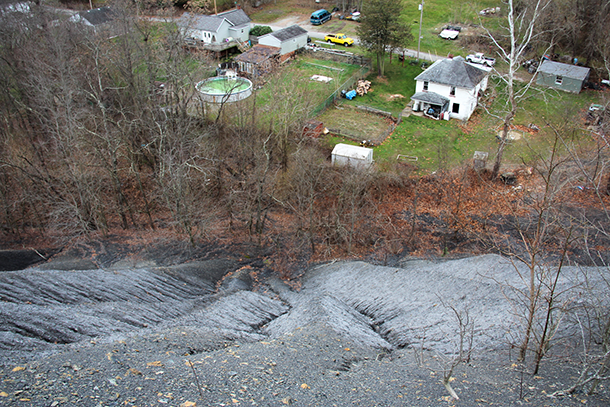
An enormous coal refuse pile hovers over the town of Fredericktown in southwestern Pennsylvania. Decades ago, companies just left piles like these behind when a mine closed. Because of this, Pennsylvania has been left with hundreds of these sites-the most of any state in the country. (Photo: Reid Frazier)
CAVAZZA: And the material erodes off here, it erodes into the river and gets into small streams it blocks storm sewer system in the towns.
FRAZIER: The pile was created before modern environmental regulations required mines to clean up their mess. Decades ago, companies just left piles like these behind when a mine stopped making money. Pennsylvania has been left with hundreds of these sites - the most of any state in the country.
CAVAZZA: We were a leader in mining for a very long time - fueled a couple of world wars and the industrial revolution. Unfortunately we're left with many problems from that.
FRAZIER: Cavazza would like to clean up this pile, but his funding source keeps shrinking.
CAVAZZA: I definitely think had we continued to get the grants the size we were getting about three or four years ago this project would be done probably within the next couple of years. But we're at the reality now where these really large dollar projects, we're probably only going to be able to tackle one per year, and there are a lot of them.
FRAZIER: What’s happening to that money? Lots of things - including the budget sequester implemented by Congress a few years ago. That’s taken millions out of the state’s cleanup program. Also, there’s this fundamental problem: the federal government pays for abandoned mine cleanup by assessing a fee on current coal production. And as current production takes a nosedive, there’s simply less money coming in to pay for clean up. Andy McAllister is with the Western Pennsylvania Coalition for Abandoned Mine Reclamation.
McAllister: We need every scrap of money we can get in this state to fix this problem.
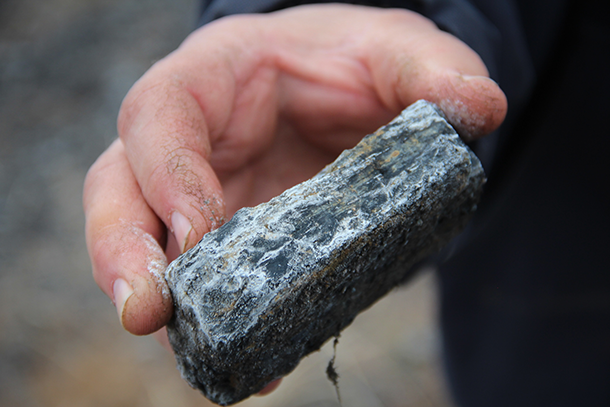
The white powder on coal refuse easily dissolves during rainstorms, and the acidic runoff damages rivers and streams. (Photo: Reid Frazier)
FRAZIER: McAllister works to get more federal dollars to pay for mine cleanups. But the economics of the coal industry are working against him. Sitting at his desk, he pulls out a sheet of paper with production figures from the last available year, 2013.
McAllister: Look at the coal - for the first time in two decades, as of 2013, US coal production fell below one billion short tons. As of 2013 it’s now 984 million short tons.
FRAZIER: Pennsylvania officials estimate the slowdown in coal will lead to about a 6 percent decline in mine cleanup money this year. The shortfall in funding will slow efforts to clean up what is essentially a slow motion environmental catastrophe in the region. Abandoned strip mines, refuse piles, and mine drainage have poisoned thousands of miles of streams in coal country. Paul Ziemkiewicz is a water scientist at West Virginia University.
ZIEMKIEWICZ: A lot of these refuse piles are in fairly remote areas, up in headwater locations, and because the acid is so concentrated coming out of these refuse piles, even though the volume is not gigantic, they can wipe out many miles of headwater streams that would otherwise be very valuable.
FRAZIER: Mining exposes rocks like iron pyrite and shale to oxygen. When water flows over these rocks, it creates an acidic stew that leaches metals into waterways, and lowers the pH of streams to the same level as vinegar.
ZIEMKIEWICZ: The fish just can't live in an environment with a pH of say, 3. That just pickles them. They just don't live.
FRAZIER: Pennsylvania alone has 5,000 miles of streams that have been impaired by mine runoff from places like the Fredericktown waste pile. Back on top of the pile, Cavazza shows me one of the culprits - a dark rock with a light frosting on its surface.
CAVAZZA: You see this lighter colored material that you see on top, these are sulphate salts, they're from the oxidation of pyrite when it rains, this is like the instant coffee of mine drainage.
FRAZIER: By simply grading the pile, capping it with soil, and seeding it with grass, the state could dramatically improve the water quality coming off of it. Cavazza’s group did just that with a nearby pile last year. One reason why THIS site is so pressing for Cavazza is that this isn’t some remote place - this dump is in the middle of a town, Fredericktown. Just ask Julie Bundy. She lives literally across the street.
BUNDY: The slate dumps. Yeah when we talk about where we live, we live across from the slate dumps. Everybody knows where that is. I think it´s just something everybody has accepted as being a part of the community.
FRAZIER: Standing on her porch, Bundy says the pile isn’t so bad during the summer. The leaves on the trees make it so you almost can’t see the pile.
BUNDY: The only time I really notice it too much is when the teenagers come down and they want to go up on the slate dumps either on their quads or dirt bikes.
FRAZIER: When she was a girl, her parents wouldn’t let her near the dump. She’s got little kids and doesn’t like the fact that people she calls "shady characters" park their cars near her house and go up onto the pile.
BUNDY: I know my neighbor told me at one time it was a farm, and there was apple orchards and everything on that property, and it was very beautiful at one time, and then, this happened.
FRAZIER: Bundy thinks it would be beautiful if someday the big pile across the street goes away. I'm Reid Frazier.
CURWOOD: Reid reports for the Allegheny Front.
Related links:
- More about Pennsylvania’s coal mines and cleanup on The Allegheny Front
- Bureau of Abandoned Mine Reclamation in the PA DEP
- Coal production is at its lowest point
- OSMRE Provides Nearly $225 Million in Funding for States and Tribes to Reclaim Abandoned Coal Mines, PA will receive $43 million of this
- Nationwide, there's a backlog of more than $4 billion worth of "high priority" abandoned mine projects
[MUSIC: Jeffrey Taylor, Shall We Gather at the River, Cumberland Records]
CURWOOD: Coming up...a novel way to use the Clean Air Act to control greenhouse gases. That's just ahead on Living on Earth. Stay tuned.
ANNOUNCER: Funding for Living on Earth comes from United Technologies, a provider to the aerospace and building systems industries worldwide. UTC Building & Industrial Systems, provides building technologies and supplies, container refrigeration systems that transport and preserve food, and medicine with brands such as Otis, Carrier, Chubb, Edwards and Kidde. This is PRI, Public Radio International.
[CUTAWAY MUSIC: Kohala, Deeper Blue, Mele O Hawaii, Sony/BMG]
The Paris Climate Accord Could Activate A Powerful Part of the Clean Air Act
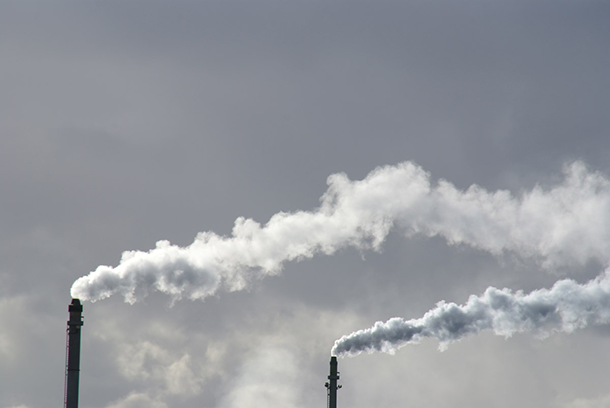
Section 115 of the Clean Air Act could allow the EPA to use a cross-sector financial tool to combat greenhouse gas emissions. (Photo: Ian Britton, Flickr CC BY-NC 2.0)
CURWOOD: It's Living on Earth, I'm Steve Curwood. Something old could become something new in the regulation of global warming gases in America, and it’s a potential game-changer. A provision of the Clean Air Act on the books since 1977 authorizes the EPA to regulate greenhouse gases across the economy when they cross international borders, as long as other countries are taking action to curb emissions. This provision, known as Section 115, was reportedly discussed by the State Department and international negotiators as part of the President’s statutory authority to regulate CO2 and meet the pledges made in Paris. It’s only been cited once before, during the Carter Administration’s efforts to deal with acid rain, though the rule making halted when President Reagan assumed office. Michael Burger is the Executive Director of the Sabin Center for Climate Change Law at Columbia University and recently wrote about Section 115. Welcome to Living on Earth.
BURGER: Thanks, Steve.
CURWOOD: First of all, tell me what is Section 115 of the Clean Air Act and why would this be useful to achieve the emissions curbs that the US has agreed to in Paris?
BURGER: Section 115 of the Clean Air Act is titled International Air Pollution, and it was included in the Clean Air Act as far back as 1965 and the provision is there in order to allow the executive branch to cooperate with foreign countries to solve international air pollution problems. Now, to invoke section 115 there are a couple of pre-requisite requirements.
CURWOOD: What would those be?
BURGER: Well, the EPA has to find that sources of pollution in the United States are causing air pollution that is endangering the public health and welfare of people in other countries. So that's the endangerment finding requirement. There's another requirement which we refer to as the reciprocity determination which is that basically the administrator also has to find that other countries or another country provides the US with basically the same rights to air pollution reduction as the US is providing to that country or those countries.
CURWOOD: So, that first requirement sounds pretty easy. I mean CO2 emitted anywhere affects every place on the planet. The second one, to what extent does the Paris agreement meet this reciprocity requirement?
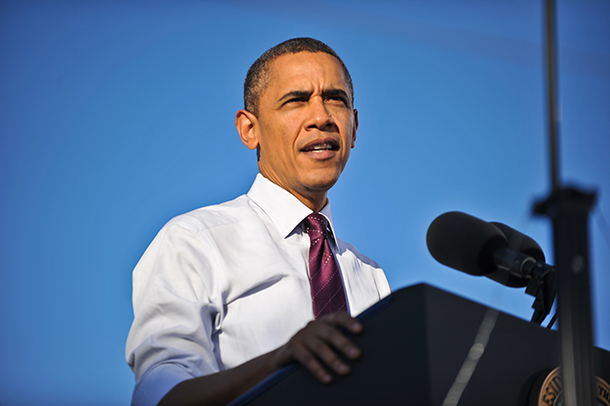
The Clean Air Act’s Section 115 could give the President a chance to institute carbon pricing without the help of Congress. (Photo: Nick Knupffer, Flickr CC BY-SA 2.0)
BURGER: Even before the Paris agreement that requirement was already met. The United Nations Framework Convention on Climate Change, a number of bilateral and multilateral agreements and understandings that the US has entered into with other countries including the China agreement where mutual pledge made by the US and China last spring should satisfy those reciprocity requirements, but the past agreement goes even further and makes the case absolutely sound, rock solid. Basically in order to find reciprocity there really are two different elements to it. There's a procedural element and a substantive element.
The Paris agreement provides for what they call an enhanced transparency mechanism through which countries are going to submit their nationally determined contributions, their plans and their pledges for reducing emissions, greenhouse gas emissions and other countries will be allowed to comment extensively on those pledges and plans. In addition, there's the fact of the plans themselves, which represent national pledges to address the international air pollution problem of climate change through greenhouse gas emissions reductions. So there you have both the procedural reciprocity and the substantive reciprocity.
CURWOOD: Tell me if I have this summarization correct. EPA has already found that CO2 is a pollutant, is a dangerous pollutant that goes across not only state lines, but international lines and the Paris agreement allows one nation to look at another's plan to deal with CO2. Now, one might read this Section 115 in the Clean Air Act as authorizing EPA to get together with the states to put together market-based mechanisms such as cap and trade to respond under the act. How accurate is that?
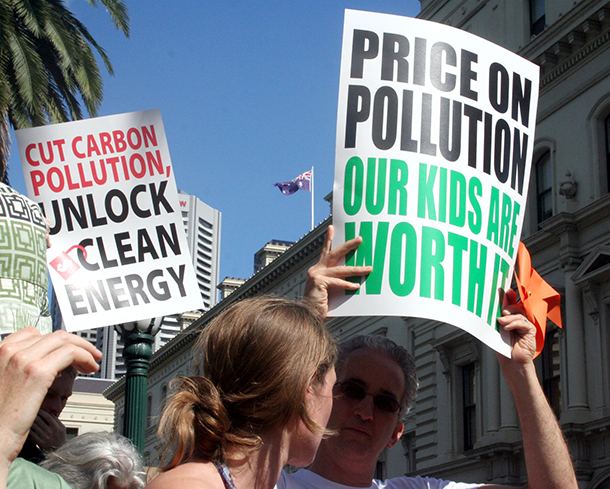
Many people think we need a carbon price to adequately address climate change. (Photo: Takver, Flickr CC BY-SA 2.0)
BURGER: Well, I think that that's absolutely correct. Section 115 provides the EPA with broad authority to address air pollution originating in United States that's causing adverse impacts on public health and welfare in other countries and there's no specific mechanism that it directs the EPA to use. It does refer EPA to Section 110 and the language in Section 110 gives states broad authority to use any mix of measures that they deem appropriate including market-based mechanisms. So, our view is that Section 115 authorizes EPA to, in effect, invoke a nationwide, economy-wide, cross-sectorial, market-based mechanism to deal with climate change and when you talk about nationwide market-based mechanisms, a cap and trade system seems a great answer.
CURWOOD: I imagine the EPA is not allowed to impose a carbon tax, which would be another mechanism.
BURGER: Right, although states working under a Section 115 program through their state implementation plans may be able to use state-based taxes to satisfy their state-based goals. So the way that we anticipate this would work, EPA would have to establish a nationwide cap for greenhouse gas emissions under Section 115. It would seem eminently reasonable for EPA to use the INDC submitted to the Paris conference as that national cap. What EPA would then do is allocate budgets to each state, basically give each state a target to meet in relationship to that national target. Once a state has its target, then each state would go through a SIP revision process, a state implementation plan revision process in order to develop a mix of measures and regulations and incentives that would achieve that state-based target.
CURWOOD: Now, what are the advantages of using an existing piece of legislation, the Clean Air Act and its Section 115, and it calls for a neutral reduction of pollutants across international boundaries rather than writing new legislation?
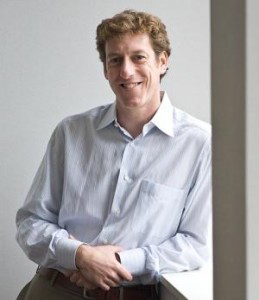
Michael Burger is the Executive Director of the Sabin Center for Climate Change Law. (Photo: Columbia University)
BURGER: Well, the fact is is that new legislation is not in the offing. You know, we're not looking at a situation where Congress is going to re-visit the failed legislation of 2009, 2010. It just does not seem likely that that's going to happen in the future. Despite that, climate change is a very very real problem and we have an international pledge and no clear pathway to achieve that international pledge on the books as of yet. One of the real advantages of section 115 is that it would provide the United States with an efficient and effective pathway to achieving the Paris agreement pledge. The Clean Power Plan doesn't quite get us there. So, we're going to need additional measures just to meet the Paris pledge. The Paris pledge itself is insufficient to keep us within a two-degree Celsius global warming target, never mind a 1.5 degree Celsius global warming target. So in the future, after 2025, we're going to need a means to enhance our mitigation ambition, and Section 115 would provide a platform for that as well. So, two of the advantages of Section 115 would be that it gives us a pathway to achieve the Paris agreement and then second that it provides us with a pathway to enhance mitigation ambition in the future.
CURWOOD: Michael Burger lectures at Columbia Law School and is Executive Director of the Sabin Center for Climate Change Law. Thank you so much for taking the time today, Mike.
BURGER: Thank you, Steve.
CURWOOD: By the way, observers close to the White House say there is not enough time left for the Obama Administration to complete an economy-wide carbon emissions reduction program such as cap and trade under Section 115. That will depend on the next Administration.
Related links:
- Legal Scholars on Pathways to Reducing Greenhouse Gas Emissions Under Section 115 of the Clean Air Act
- Section 115 could expand the reach of the Clean Air Act
- This audacious plan would let Obama enact an economy-wide cap-and-trade system — with a law already passed by Congress
- More about the Endangerment finding requirement and Reciprocity determination
- Michael Burger is the Director of the Sabin Center for Climate Change Law at Columbia
- Section 110-- State implementation plans for national primary and secondary ambient air quality standards
[MUSIC: Lynard Skynryd/Ronnie van Zant/Ed King, Swamp Music, Second Helping, MCA]
Beyond the Headlines
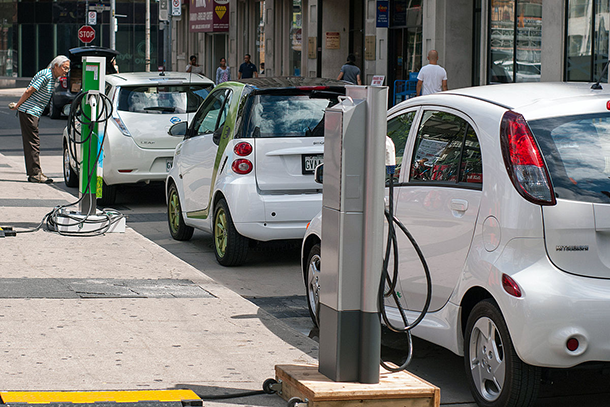
From farthest to closest, a Nissan Leaf, a Smart ED, and a Mitsubishi i MiEV. Currently, there are about 400,000 electric vehicles on US roads today. (Photo: Mariordo, Wikimedia Commons CC BY-SA 2.0)
CURWOOD: Let’s delve beyond the headlines now with Peter Dykstra of the DailyClimate dot org and Environmental Health News – that’s EHN.org. He’s on the line now from Conyers, Georgia. How’s it going Peter?
DYKSTRA: Hi, Steve. You know, the Detroit Auto Show happens every January and it’s kind of a place for big dreams, but this year, there was a big dream that got deflated.
CURWOOD: Oh? What was that?
DYKSTRA: Well, back in the 2008 presidential campaign, candidate Barack Obama set a goal of a million electric vehicles on US roads by 2015. They sorta walked that goal back in 2013, and then this year it went completely flat.
CURWOOD: Did you buy one?
DYKSTRA: No, I didn’t buy one, and less than half the people to meet that million-car-goal bought them either. There were only 400-thousand on the road as of 2015.
CURWOOD: Well, you didn’t buy one; I didn’t buy one. What went wrong?
DYKSTRA: Well, several things: battery technology in electric vehicles is not as far along as some people had hoped. The costs for those batteries and the cars are too high, and of course we have those low, low gas prices. When Obama made that promise as a candidate back in 2008, gas prices were 4 bucks a gallon; now they’re less than half that.
CURWOOD: Yeah, you’re right. I can get it for a buck-59 in my neighborhood. Hey, what else do you have for us today?
DYKSTRA: Well, let’s call this next one “CSI Environment.” There were some fun developments in tracking pollution and environmental crime from satellites.
CURWOOD: Ah, the Big Tree-hugger is watching you…
DYKSTRA: Well, not so much a big tree-hugger; it’s a little nonprofit called SkyTruth. They’re leading the way and teaming with some big outfits like Google and others, with satellite data and images to track fracking sites, oil spills, illegal logging, illegal mining, water theft and particularly illegal fishing in our oceans.
CURWOOD: So, what are the big collars these eco-cops have made?
DYKSTRA: They’ve had a few. The SkyTruth folks set out scouring publicly available images for oil spills and other accidents. Back in 2009, they found a huge spill off Australia. Then, they helped reveal the next year how big the Deepwater Horizon oil spill was in the Gulf of Mexico.
CURWOOD: Ah! That’s a pretty good pinch.
DYKSTRA: Last year, they helped the government of Palau apprehend several fishing boats operating in protected waters.
CURWOOD: And that’s a pretty big ocean out there.
DYKSTRA: Yeah, until recently, Palau only had one boat to patrol an ocean area the size of Texas. Can you imagine Texas only having one police car? That eye in the sky is welcome help for a place like Palau. Remember, we’re talking about a small, tiny nonprofit and the tiny island nation leading the way on this. If larger countries—maybe even the ones that are doing the illegal logging or fishing—get involved, it’s a potential game-changer.
CURWOOD: So, what do you have for us today from history?
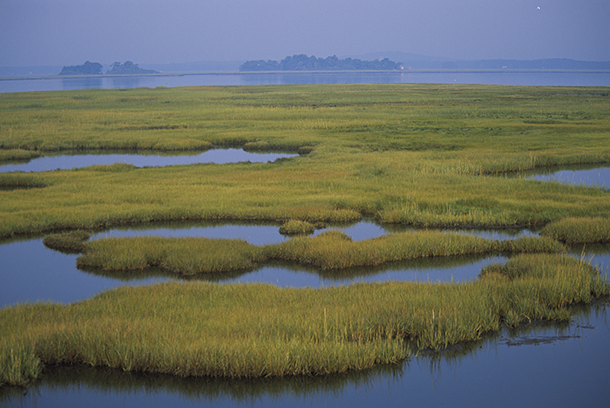
Coastal wetlands at Parker River National Wildlife Refuge in Massachusetts. (Photo: U.S. Fish and Wildlife Service Northeast Region, Flickr CC BY 2.0)
DYKSTRA: It’s one of those obscure international treaties turning 45 years old this week, the Ramsar Convention on Wetlands. It’s named that because it was adopted in Ramsar, Iran in 1971. It helps nations identify and protect their vital wetlands. There are over 2,000 wetlands listed in Ramsar for their ecological and commercial value, and169 nations that have signed on.
CURWOOD: So, what kind of teeth does this deal have?
DYKSTRA: Well, there’s almost no such thing as an ironclad international, environmental agreement, but Ramsar gives some leverage in protecting places in the US like the Chesapeake Bay and Delaware Bay or floodplains and freshwater wetlands in the Upper Mississippi. Internationally, you’ve got places like Vietnam’s Mekong delta or the Okavango in southern Africa. The threats to wetlands are still huge, but even wetlands need street cred, and the Ramsar Convention helps, so happy 45th birthday.
CURWOOD: Alright. Now Peter Dykstra’s with Environmental Health News; that’s ehn.org and TheDailyClimate.org. Thanks, Peter, we’ll talk to you next time.
DYKSTRA: Alright, Steve, thanks a lot. We’ll talk to you soon.
CURWOOD: And there’s more on these stories at LOE.org.
Related links:
- U.S. may not hit one million electric vehicles until 2020
- In 2013, U.S. backs off goal of one million electric cars by 2015
- SkyTruth
- Tiny Team Uses Satellites to Bust Illegal Fishing Worldwide
- SkyTruth helps crack down on illegal fishing in Palau
- Timor Sea Drilling Spill - Satellite Images Reveal Extensive Slicks
- The Clean Power Plan Overcomes Another Attack
- The Ramsar Convention
BirdNote: Costa Rica's Morning Chorus

Purple-throated Fruitcrow is found in humid forests from southern Nicaragua south to northwestern Ecuador and to Bolivia. (Photo: Patty McGann FCC)
BIRDNOTE®/COSTA RICA SUNRISE
MUX - BIRDNOTE® THEME
It’s still early in the winter season, and though it was a monster, we’ve only had one major snowstorm so far in the northeast. But that doesn’t stop some of us from dreaming about waking up somewhere warmer and more enticing…such as the landscape Mary McCann evokes in today’s BirdNote®.
http://birdnote.org/show/costa-rica-winter-sunrise
BirdNote®
Costa Rica Winter Sunrise
[Bay Wren song duet, https://soundcloud.com/encyclopedia-of-life/baywren]
On a winter morning in Costa Rica, a pair of Bay Wrens sings a brisk duet just before sunrise. Though the Bay Wrens stay well hidden in the underbrush, they have all the decibels they need to make themselves known.

Montezuma Oropendolas are highly dimorphic in size. The species is polygynous, and dominant males perform most of the copulations at a colony. (Photo: Robert Shea FCC)
[Bay Wren song duet, https://soundcloud.com/encyclopedia-of-life/baywren]
A breeze wafts in off the Caribbean Sea, less than a mile away, across the tropical lowland forest, fluttering the leaves of a tall giant fig tree hung with flowering bromeliads. Perched in the upper canopy, a small group of Keel-billed Toucans calls out.
[Keel-billed Toucan calls]
Their comically large bills are painted in lime green, turquoise, orange, and magenta. In a nearby tree, Purple-throated Fruit Crows add their voices to the sunrise chorus.
[http://macaulaylibrary.org/audio/187913]
The male fruit crows are jet-black with reddish-purple throats. Alongside the fruit crows, a huge oriole-like bird pivots upside down and belts out an electrifying series of notes:

Keel-billed Toucan ordinarily utters a single note, a shrill, frog-like cree which it repeats in a series of about five to seven notes. Hatchlings have a buzzy call, while juvenal toucans whine or emit a wailing sound. (Photo: MLL-FCC)
[http://macaulaylibrary.org/audio/127299]
It’s a male Montezuma Oropendola, with one of the most distinctive voices in the tropics.
[http://macaulaylibrary.org/audio/127299]
Finally, a Bright-rumped Attila calls from its perch hidden deep in the canopy.
[http://macaulaylibrary.org/audio/113384]
The Attila will repeat its maniacal phrases until well after sunrise, reminding us again and again that it’s morning in Costa Rica. I'm Mary McCann.
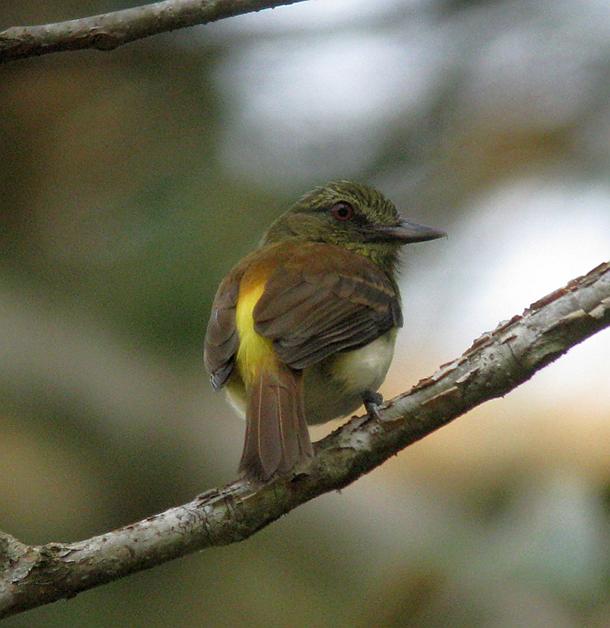
Twelve subspecies of Bright-rumped Attila are generally recognized across this species’ broad range, stretching from northwest Mexico to northwest South America. Their range spans much of the lowland in the northern two-thirds of the continent. Another population can also be found in the Atlantic Forest of eastern Brazil. (Photo: Paul Bedell-FCC)
###
Written by Bob Sundstrom
Bay Wren from Xeno-Canto (XC11512] recorded by Nick Athanas; Keel-billed Toucan from Xeno-Canto recorded by Melinda Wood; Purple-throated Fruitcrow [187913] recorded by P K Donahue, Montezuma Oropendola [127299] recorded by C A Marantz and Bright-rumped Attila [113384] recorded by C A Marantz, all courtesy of The Macaulay Library of Natural Sounds at the Cornell Lab of Ornithology, Ithaca, New York.
BirdNote’s theme music was composed and played by Nancy Rumbel and John Kessler.
Producer: John Kessler
Executive Producer: Dominic Black
© 2016 Tune In to Nature.org January 2016 Narrator: Mary McCann
http://birdnote.org/show/costa-rica-winter-sunrise
CURWOOD: You’ll find pictures of these exotically named and feathered songsters at our website, LOE.org.
Related links:
- More about Costa Rica’s birds on BirdNote
- Bay Wren (Cantorchilus nigricapillus) duet
- About the Bay Wren
- About the Keel-billed Toucan
- Purple-throated Fruitcrows (Querula purpurata) call
- About the Purple-throated Fruitcrow
- Montezuma Oropendola (Psarocolius Montezuma) call
- About the Montezuma Oropendola
- Bright-rumped Attila (Attila spadiceus) call
- About the Bright-rumped Attila
CURWOOD: Next time on Living on Earth, a novel material offers a new way to store and release energy from sunlight.
MAN: We use these molecules that can absorb UV light, and instead of generating charges what they do is change shape and by changing shape they can store chemical energy this way.
CURWOOD: And this could come to your clothing soon. That’s next time, on Living on Earth.
[MUSIC: Gary Burton/Antonio Carlos Jobim/Vinicius de Moraes, O Grande Amour, Recorded Live at KPLU]
CURWOOD: Living on Earth is produced by the World Media Foundation. Our crew includes Naomi Arenberg, Bobby Bascomb, Emmett Fitzgerald, Lauren Hinkel, Helen Palmer, Adelaide Chen, Jenni Doering, John Duff, Amber Rodriguez, Jaime Kaiser and Jennifer Marquis. And we welcome a new faculty fellow this week – Peter Boucher. Tom Tiger engineered our show, with help from Jeff Wade, Jake Rego and Noel Flatt. Alison Lirish Dean composed our themes. You can find us anytime at LOE.org - and like us, please, on our Facebook page - it’s PRI’s Living on Earth. And we tweet from @LivingOnEarth. I'm Steve Curwood. Thanks for listening.
ANNOUNCER1: Funding for Living on Earth comes you, our listeners, and from the University of Massachusetts Boston, in association with its School for the Environment, developing the next generation of environmental leaders. And from the Grantham Foundation for the protection of the environment, supporting strategic communications and collaboration in solving the world’s most pressing environmental problems. And Gilman Ordway for coverage of conservation and environmental change. Also from SolarCity, America’s solar power provider. SolarCity is dedicated to revolutionizing the way energy is delivered by giving customers a renewable alternative to fossil fuels. Information at 888-997-1703. That’s 888-997-1703.
ANNOUNCER2: PRI. Public Radio International.
Living on Earth wants to hear from you!
Living on Earth
62 Calef Highway, Suite 212
Lee, NH 03861
Telephone: 617-287-4121
E-mail: comments@loe.org
Newsletter [Click here]
Donate to Living on Earth!
Living on Earth is an independent media program and relies entirely on contributions from listeners and institutions supporting public service. Please donate now to preserve an independent environmental voice.
NewsletterLiving on Earth offers a weekly delivery of the show's rundown to your mailbox. Sign up for our newsletter today!
 Sailors For The Sea: Be the change you want to sea.
Sailors For The Sea: Be the change you want to sea.
 The Grantham Foundation for the Protection of the Environment: Committed to protecting and improving the health of the global environment.
The Grantham Foundation for the Protection of the Environment: Committed to protecting and improving the health of the global environment.
 Contribute to Living on Earth and receive, as our gift to you, an archival print of one of Mark Seth Lender's extraordinary wildlife photographs. Follow the link to see Mark's current collection of photographs.
Contribute to Living on Earth and receive, as our gift to you, an archival print of one of Mark Seth Lender's extraordinary wildlife photographs. Follow the link to see Mark's current collection of photographs.
 Buy a signed copy of Mark Seth Lender's book Smeagull the Seagull & support Living on Earth
Buy a signed copy of Mark Seth Lender's book Smeagull the Seagull & support Living on Earth

